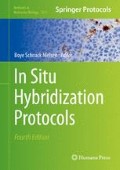Abstract
Fluorescence in situ hybridization with PNA probes (PNA-FISH) that target specific bacterial ribosomal RNA sequences is a powerful and rapid tool for identification of bacteria in clinical samples. PNA can diffuse readily through the bacterial cell wall due to its uncharged backbone, and PNA-FISH can be performed with high specificity due to the extraordinary thermal stability of RNA-PNA hybrid complexes. We describe a PNA-FISH procedure and provide examples of the application of PNA-FISH for the identification of bacteria in chronic wounds, cystic fibrosis lungs, and soft tissue fillers. In all these cases, bacteria can be identified in biofilm aggregates, which may explain their recalcitrance to antibiotic treatment.
Access this chapter
Tax calculation will be finalised at checkout
Purchases are for personal use only
References
Amann R, Krumholz L, Stahl DA (1990) Fluorescent-oligo-nucleotide probing of whole cells for determinative, phylogenetic, and environmental studies in microbiology. J Bacteriol 172:762–770
Giovannoni SJ, DeLong EF, Olsen GJ et al (1988) Phylogenetic group-specific oligodeoxynucleotide probes for identification of single microbial cells. J Bacteriol 170:720–726
DeLong EF, Wickham GS, Pace NR (1989) Phylogenetic stains: ribosomal RNA-based probes for the identification of single microbial cells. Science 243:1360–1363
Nielsen PE, Egholm M, Berg RH et al (1991) Sequence selective recognition of DNA by strand displacement with a thymine substituted polyamide. Science 254:1497–1500
Egholm M, Buchardt O, Christensen L et al (1993) PNA hybridizes to complementary oligonucleotides obeying the Watson-Crick hydrogen bonding rules. Nature 365:566–568
Lefmann M, Schweickert B, Buchholz P et al (2006) Evaluation of peptide nucleic acid-fluorescence in situ hybridization for identification of clinically relevant mycobacteria in clinical specimens and tissue sections. J Clin Microbiol 44:3760–7376
Seidell JC (2000) Obesity, insulin resistance and diabetes—a worldwide epidemic. Br J Nutr 83(Suppl 1):S5–S8
James PT (2004) Obesity: the worldwide epidemic. Clin Dermatol 22:276–280
James PT, Leac R, Kalamara R et al (2001) The worldwide obesity epidemic. Obes Res Suppl 4:228S–233S
Mark DB, Van de Verf FJ, Simes RJ et al (2007) Cardiovascular disease on a global scale: defining the forward for research and practice. Eur Heart J 28:2678–2684
Gottrup F (2004) A specialized wound healing center concept: importance of a multidisciplinary department structure and surgical treatment facilities in the treatment of chronic wounds. Am J Surg 187:38S–43S
Hahler B (2006) An overview of dermatological conditions commonly associated with the obese patient. Ostomy Wound Manage 52:34–36
Bowler PG (2002) Wound pathophysiology, infection and therapeutic options. Ann Med 34:419–427
Schultz GS, Sibbald RG, Falanga V et al (2003) Wound bed preparation: a systematic approach to wound management. Wound Repair Regen 11(Suppl 1):S1–S28
Bjarnsholt T, Kirketerp-Moller K, Jensen PO et al (2008) Why chronic wounds will not heal: a novel hypothesis. Wound Repair Regen 16: 2–10
Kirketerp-Møller K, Jensen PO, Fazli M et al (2008) Distribution, organization, and ecology of bacteria in chronic wounds. J Clin Microbiol 46:2717–2722
Fazli M, Bjarnsholt T, Kirketerp-Møller K, Jørgensen B et al (2009) Nonrandom distribution of Pseudomonas aeruginosa and Staphylococcus aureus in chronic wounds. J Clin Microbiol 47:4084–4089
Wolcott RD, Rhoads DD (2008) A study of biofilm-based wound management in subjects with critical limb ischaemia. J Wound Care 17:145–148, 150–2, 154–5
Wolcott RD, Rhoads DD, Bennett ME et al (2010) Chronic wounds and the medical biofilm paradigm. J Wound Care 19:45–46, 48–50, 52, 3
Boucher RC (2002) An overview of the pathogenesis of cystic fibrosis lung disease. Adv Drug Deliv Rev 54:1359–1371
Donaldson SH, Boucher RC (2003) Update on pathogenesis of cystic fibrosis lung disease. Curr Opin Pulm Med 9:486–491
Szaff M, Høiby N, Flensborg EW (1983) Frequent antibiotic therapy improves survival of cystic fibrosis patients with chronic Pseudomonas aeruginosa infection. Acta Paediatr Scand 72: 651–657
Høiby N, Koch C (2000) Maintenance treatment of chronic pseudomonas aeruginosa infection in cystic fibrosis. Thorax 55:349–350
Høiby N (2011) Recent advances in the treatment of Pseudomonas aeruginosa infections in Cystic Fibrosis. BMC Med 9:32
Bjarnsholt T, Jensen PO, Fiandaca MJ et al (2009) Pseudomonas aeruginosa biofilms in the respiratory tract of cystic fibrosis patients. Pediatr Pulmonol 44:547–558
Broder KW, Cohen SR (2006) An overview of permanent and semipermanent fillers. Plast Reconstr Surg 118:7S–14S
Christensen L (2007) Normal and pathologic tissue reactions to soft tissue gel fillers. Dermatol Surg 33(Suppl 2):S168–S175
Christensen L, Breiting V, Janssen M et al (2005) Adverse reactions to injectable soft tissue permanent fillers. Aesthetic Plast Surg 29:34–48
Christensen L, Breiting V, Vuust J et al (2006) Adverse reactions following injection with a permanent facial filler polyacrylamide hydrogel (Aquamid): cause and treatment. Eur J Plast Surg 28:464
Christensen LH (2009) Host tissue interaction, fate, and risks of degradable and nondegradable gel fillers. Dermatol Surg 35(Suppl 2): 1612–1619
Bjarnsholt T, Tolker-Nielsen T, Givskov M et al (2009) Detection of bacteria by FISH in culture-negative soft tissue filler lesions. Dermatol Surg 35:1620–1624
Christensen L, Breiting V, Bjarnsholt T et al (2013) Bacterial infection as a likely cause of adverse reactions to polyacrylamide hydrogel fillers in cosmetic surgery. Clin Infect Dis 56: 1438–1444
Acknowledgement
This work was supported by grants from the Lundbeck Foundation, the Danish Strategic Research Council, and the Danish Council for Independent Research.
Author information
Authors and Affiliations
Corresponding author
Editor information
Editors and Affiliations
Rights and permissions
Copyright information
© 2014 Springer Science+Business Media New York
About this protocol
Cite this protocol
Fazli, M., Bjarnsholt, T., Høiby, N., Givskov, M., Tolker-Nielsen, T. (2014). PNA-Based Fluorescence In Situ Hybridization for Identification of Bacteria in Clinical Samples. In: Nielsen, B. (eds) In Situ Hybridization Protocols. Methods in Molecular Biology, vol 1211. Humana Press, New York, NY. https://doi.org/10.1007/978-1-4939-1459-3_21
Download citation
DOI: https://doi.org/10.1007/978-1-4939-1459-3_21
Published:
Publisher Name: Humana Press, New York, NY
Print ISBN: 978-1-4939-1458-6
Online ISBN: 978-1-4939-1459-3
eBook Packages: Springer Protocols

